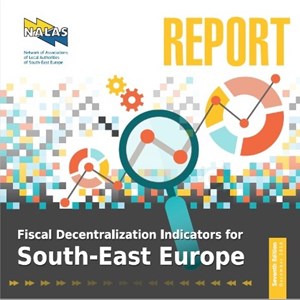
This is the seventh edition of the Report which is an ongoing effort of NALAS’ Fiscal Decentralisation Task Force to provide policy–makers and analysts with reliable comparative data on municipal finances and up to date information on intergovernmental fiscal relations in South–East Europe.
The report is structured in four sections. The first reviews the data used in the report and discusses some basic methodological issues. The second provides an overview of the structure and functions of municipal governments in the region. The third section examines selected indicators of macro–economic performance and fiscal decentralisation. The fourth one focuses on the evolution of intergovernmental finances in each NALAS’ member country or entity.
The main findings of the Report are the following:
- There is an ongoing tendency of concentration of people in capital and metropolitan cities, despite the region’s diversity in terms of territorial organization. In Albania, Serbia, Macedonia and Montenegro over 20% of the population lives in the capital cities, which creates significant pressures and challenges for improved service delivery and intergovernmental finance systems.
- Local government challenges to provide better services and improve the quality of life of citizens are exacerbated by a general stagnation or deterioration of local finance arrangements that are not able to keep up or quickly respond to local government needs and developments.
- While it is difficult to judge the adequacy of local government revenues relative to their expenditure needs, there seems little question that in many places in the region municipalities are underfunded, and central governments are not giving them a fair share of the overall fiscal pie. On average, in 2017, SEE local government revenue as a share of GDP stood at 5.9%, almost half of their counterparts in the EU that benefit from an average of 10.7%.
- The level of local fiscal autonomy is decreasing in many SEE countries. On average local government revenues in SEE decreased by 0.5% between 2015 and 2017, both as a percent of the GDP and Total Public Revenues. Further, compared to 2006, NALAS’s baseline year, the share of revenues over which local governments can exercise independent decision-making has decreased, while the share of conditional block grants and specific-purpose investment grants has increased by 50% and 30% respectively.
- Local government powers to set and collect taxes, fees and charges are in continuous change – sometimes without a due process of consultation and/or compensation, under the general expectations of improved business climate and relieved fiscal burdens to taxpayers that would result in more job-creation. Unfortunately, this depresses local governments efforts too.
- Regardless of level of development and membership to the EU, SEE local governments continue to face similar challenges as regards to own revenue generation, including the frequent and continuous amendment of the legal framework; outdated fiscal registers; weak tax compliance and enforcement, while commitment of policymakers to make local taxation effective is critical everywhere in the region.
- Additionally, there seems to be an inverse relationship between the level of decentralisation measured by the scope of the social functions devolved to the local governments and the size of the public sector. The data suggests that surprisingly decentralisation has gone furthest in places where the overall public sector is relatively small, and to minor extent where potentially national governments face significant trouble collecting taxes.
- The functional allocation of expenditures shows that SEE local governments spend most of their budgets on Education and Housing and Community Amenities: Education takes 40-60% of municipal budgets in Moldova, Slovenia, Kosovo and Bulgaria – which is 2-3 times more than the EU28 average. In Albania, Croatia and Turkey, local governments spend one quarter to one third of all expenditures on housing and community amenities. Environmental protection is the function where almost all SEE countries spend the least.
- SEE local governments spend, on average, a third of their budgets on personnel wages/salaries costs which is almost equal to the EU and, while the share of spending for capital investments is, on average, twice as much as their counterparts in the EU. The report provides a comprehensive analysis of the spending patterns of SEE as a region and individual countries, including historic data from 2006, both as a percent of the total, in million Euro or in Euro per capita.
In addition to providing information on the status and development of the intergovernmental finance systems in SEE, this edition puts more emphasis on service responsibilities of local governments and their revenue raising capacities, identifying the major developments and challenges faced by local governments as regards to the collection of local taxes, fees and charges.
The report publishes for the first time the allocation of local expenditures according to the Classification of the Functions of Government Methodology (COFOG)[1], showing not only what SEE local governments do but also what their spending priorities are. Additionally, the report, for the first time includes data in terms of millions of euro and in Euro per capita terms, which will certainly be of help for analysts, practitioners and policymakers to better understand the situation in each country and prepare their own even more detailed analysis.
For downloading the full Report:
[1] The Classification of the functions of government (COFOG) was developed by the Organization for Economic Co-operation and Development and published by the United Nations Statistical Division as a standard classifying the purposes of government activities around the world.
 2018 Fiscal Decentralisation Report
2018 Fiscal Decentralisation Report